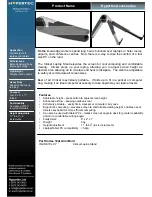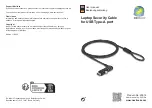
Part III: Appendixes
Glossary
294
Boot Mode:
The standard operating mode for most computers. In Boot
Mode, you must always save your work and exit the application
before you turn off the computer. When you turn on the computer
again, the computer performs its entire startup procedure, and you
have to restart your applications before you can continue working.
boot priority (startup sequence):
The order in which the computer
accesses its disk drives to locate the startup files. Under the default
startup sequence, the computer looks for the startup files in the
floppy disk drive before checking the hard disk.
briefcase:
A Windows 95, Windows 98 and Windows NT feature that
allows you to update multiple versions of a file located on different
computers.
buffer:
An area of memory where information is held until it can be
processed. Buffers are frequently used to compensate for the fact
that some parts of the system are faster than others. For example, the
computer sends information to a printer many times faster than even
the fastest printer can handle it. A print buffer stores printer
information, enabling the computer to continue with other tasks. As
the printer prints a page, it looks in the buffer to see what to do next.
bus:
An electrical circuit that connects the microprocessor with other
parts of the computer, such as the video adapter, disk drives and
ports. It is the highway along which data flows from one device to
another. See also
local bus
.
bus speed:
The speed at which the central processing unit (CPU)
communicates with the other elements of the computer. For
example, the speed at which data moves between the CPU and the
serial ports.
byte:
A sequence of eight bits. A byte is the smallest addressable unit of
data. Each byte represents an integer up to 255 in decimal
(11111111 in binary, or FF in hexadecimal), or a character (such as
a letter, numeral, or other symbol). See also
binary
,
bit, gigabyte,
hexadecimal, kilobyte
,
megabyte
.
C
cache:
An area of very fast memory in which frequently used
information is duplicated for quick access. Accessing data from
cache is faster than accessing it from system Random Access
Memory. See also
disk cache
.
Summary of Contents for 8100 series
Page 17: ...xvii ...
Page 24: ......
Page 55: ...Part I Getting to Know Your Computer Getting Started When and how to turn off the computer 29 ...
Page 111: ...Part I Getting to Know Your Computer Learning the Basics Caring for your computer 85 ...
Page 136: ......
Page 185: ...Part II Technical Reference Toshiba Utilities Expansion device properties 159 ...
Page 219: ...Part II Technical Reference Keeping Your Files Safe Hard disk drive passwords Windows NT 193 ...
Page 277: ...Part II Technical Reference Troubleshooting Guide Toshiba s worldwide offices 251 ...
Page 278: ......
Page 285: ...Part III Appendixes Hot Keys 259 ...
Page 286: ...Appendix B Built in features 261 Optional accessories and devices 268 Specifications 270 ...
Page 298: ...Appendix C ...
Page 308: ...Appendix E ...
Page 312: ......
Page 342: ...Part III Appendixes Glossary 316 ...
















































